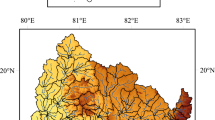Abstract
In this study, changes in daily weather states were treated as a complex Markov chain process, based on a continuous-time watershed model (soil water assessment tool, SWAT) developed by the Agricultural Research Service at the U.S. Department of Agriculture (USDA-ARS). A finer classification using total cloud amount for dry states was adopted, and dry days were classified into three states: clear, cloudy, and overcast (rain free). Multistate transition models for dry- and wet-day series were constructed to comprehensively downscale the simulation of regional daily climatic states. The results show that the finer, improved, downscaled model overcame the oversimplified treatment of a two-weather state model and is free of the shortcomings of a multistate model that neglects finer classification of dry days (i.e., finer classification was applied only to wet days). As a result, overall simulation of weather states based on the SWAT greatly improved, and the improvement in simulating daily temperature and radiation was especially significant.
Similar content being viewed by others
References
Bardossy, A., and E. J. Plate, 1991: Modeling daily rainfall using a semi-Markov representation of circulation pattern occurrence. J. Hydrol. 122, 33–47.
Bouraoui, F., L. Galbiati, and G. Bidoglio, 2002: Climate change impacts on nutrient loads in the Yorkshire Ouse catchment (UK). Hydrology and Earth System Sciences, 6(2), 197–209.
Chin, E. H., 1977: Modeling daily precipitation occurrence process with Markov chain. Water Resources Res., 13(6), 949–956.
Ding, Y. G., 1994: Research of universality of Gamma distribution model of precipitation. Scientia Atmospherica Sinica, 18(5), 552–560. (in Chinese)
Ding, Y. G., and Y. C. Zhang, 1989: A stochastic simulation test for climatological features of precipitation. Journal of Nanjing Institute of Meteorology, 12(2), 146–154. (in Chinese)
Ding, Y. G., and T. Niu, 1990: A Markov chain simulation for dry and wet month runs. Journal of Nanjing Institute of Meteorology, 13(3), 286–296. (in Chinese)
Ding, Y. G., B. Y. Cheng, and Z. H. Jiang, 2008: A newly-discovered GPD-GEV relationship together with comparing their modelings of extreme precipitation in summer. Adv. Atmos. Sci., 25(3), 507–516, doi: 10.1007/s00376-008-0507-5.
Ding, Y. G., J. L. Zhang, and Z. H. Jiang, 2009: Simulation experiments of extreme precipitation based on multi-status Markov Chain Model. Acta Meteorologica Sinica, 67(1), 20–27. (in Chinese)
Green, J. R., 1970: A generalized probability model for sequences of wet and dry days. Mon. Wea. Rev., 93, 338–341
Liao, Y. M., Q. Zhang, and D. L. Chen, 2004: The precipitation simulation using a stochastic weather generator over China region. Acta Geographica Sinica, 59(5), 689–698. (in Chinese)
Neitsch, S. L., J. G. Arnold, J. R. Kinlry, J. R. Williams, and K. W. King, 2002: Soil and water assessment tool theoretical documentation: Version 2000. TWRI Report TR-191, Texas Water Resources Institute, College Station, Texas, 483pp.
Neitsch, S. L., J. G. Arnold, J. R. Kiniry, and J. R. Williams, 2005: Soil and water assessment tool theoretical documentation: Version 2005. Texas Water Resources Institute, College Station, Texas, 476pp
Katz, R. W., 1974: Computing probabilities associated with Markov chain model for precipitation. J. Appl Meteor, 15, 953–954.
Palutikof, J. P., C. M. Goodess, S. J. Watkins, and T. Holt, 2002: Generating rainfall and temperature scenarios at multiple sites: examples from the Mediterranean. J. Climate, 15, 3529–3548.
Richardson, C. W., 1981: Stochastic simulation of daily precipitation, temperature and solar radiation. Water Resources Res, 17(1), 182–190.
Racsko, P., L. Szeidl, and M. Semenov, 1991: A serial approach to local stochastic weather models. Ecological Modelling, 57, 27–41.
Yao, Z. S., 1984: Basis of Climatic Statistics. Science Press, Beijing, China, 594pp. (in Chinese)
Yao, Z. S., and Y. G. Ding, 1990: Climate Statistics. Chinese Meteorological Press, Beijing, 698–721. (in Chinese)
Zhang, Y. C., 1990: A stochastic distribution model for N daily rainfall. Journal of Nanjing Institute of Meteorology, 13(1), 23–30. (in Chinese)
Zhang, Y. C., and Y. G. Ding, 1990: Statistical characteristics of daily rainfall series at five representative stations in Eastern China. Journal of Nanjing Institute of Meteorology, 13(2), 194–203. (in Chinese)
Author information
Authors and Affiliations
Corresponding author
Rights and permissions
About this article
Cite this article
Jiang, Z., Ding, Y., Zheng, C. et al. An improved, downscaled, fine model for simulation of daily weather states. Adv. Atmos. Sci. 28, 1357–1366 (2011). https://doi.org/10.1007/s00376-011-0086-8
Received:
Revised:
Published:
Issue Date:
DOI: https://doi.org/10.1007/s00376-011-0086-8




